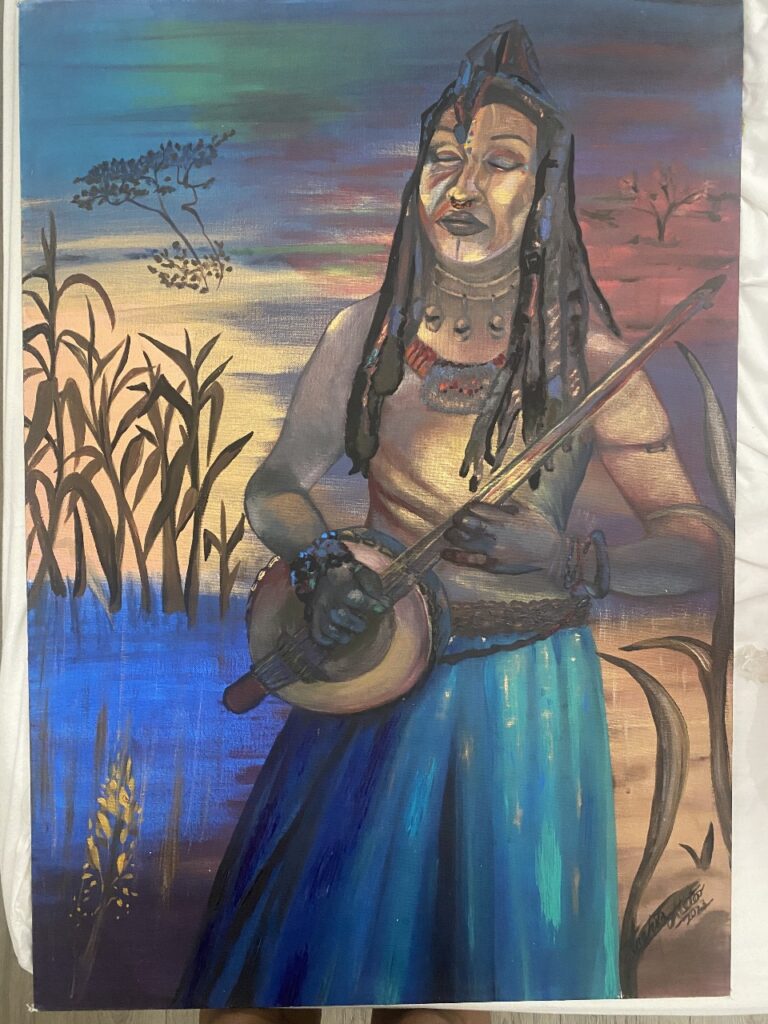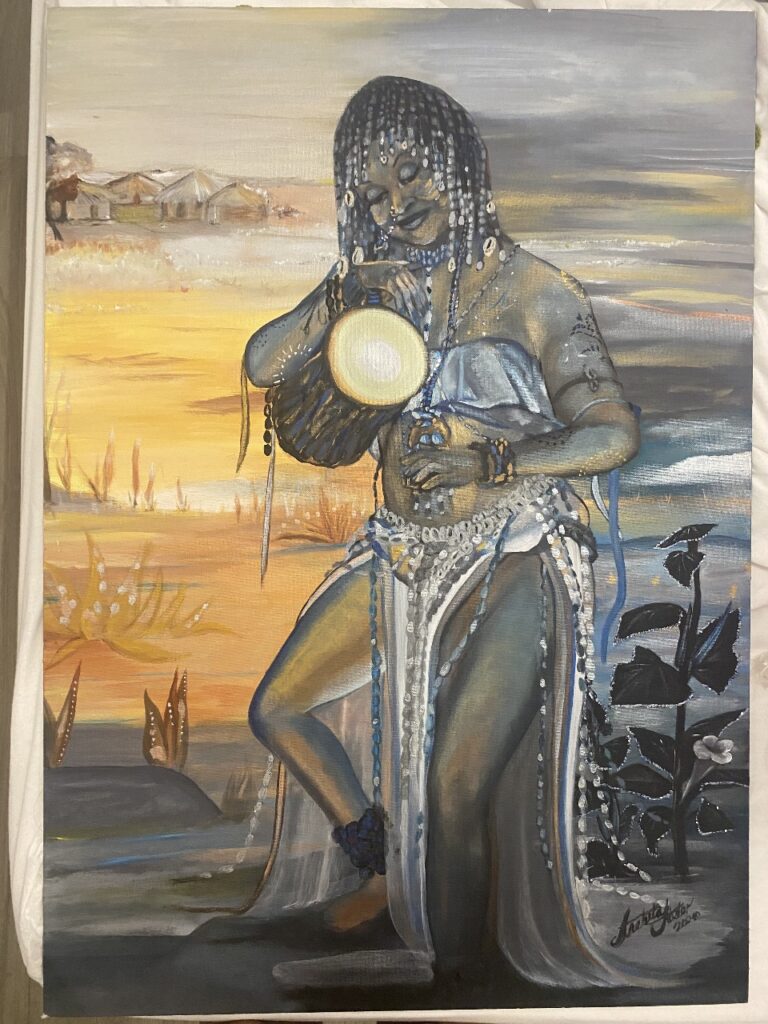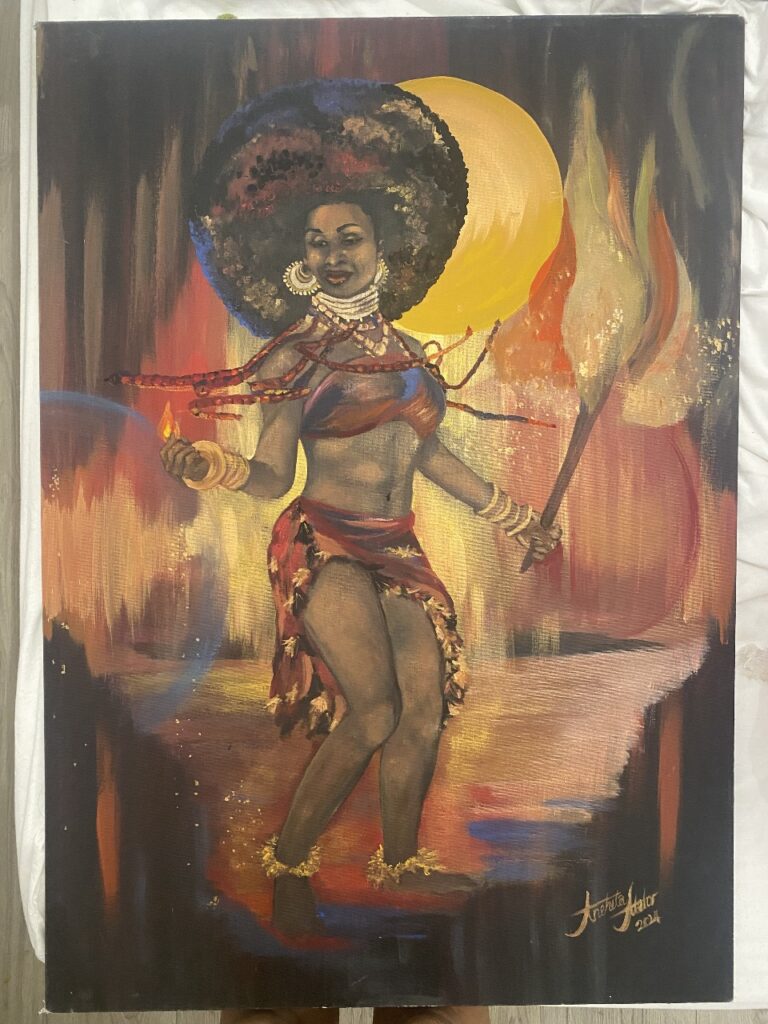Working broadly in acrylic, oil, watercolour, and pastel, Anehita Aletor often incorporates unconventional materials including vintage fabrics, archival material and found objects to create mixed media pieces distinguishable by their surface textures and illustrative qualities.Largely self-taught, her figurative paintings betray a concern with the human condition, the hallmark of her art. This thrust is accentuated through a preoccupation with portraiture as evidenced in the expressively painted features of her subjects captured in confident, assertive gaze.
The artist’s psychological introspection, exploration of identity, ethnicity and belonging inform many of her works. Straddling the traditional and the modern, they sometimes address unpopular opinion and values, ultimately weaving nuanced personal and collective narratives of humanity, culture and society.

Engaging several themes, Aletor beckons to viewers to transcend the mundane and embrace “deeper soul-searching testaments of the enduring nature of the human spirit.” Indeed, she views her works as a “tapestry of inquisitions”, inviting her audience to speculate and probe to shape their interpretation.
Significantly, Anehita Aletor engages these themes in series, which serves as a useful device to propagate her underlying philosophy, stimulate new thinking and ideas as well as raise pertinent questions. She “asserts her art “stems from a shared origin— the divine source, which extends like the branches of a fruit-bearing tree, dispersing its seeds to fertile ground.” Her series of three paintings christened ‘Woman and Passion’, displayed on August 24, 2024 at the Real Time Film Festival Exhibition Worcester in the United Kingdom, is a recent exemplar. As suggested by its apt title, it resonates with femininity, strength, and cultural identity while exploring the female connection to the elements earth, wind, fire, and water. This body of work is an evolution from Aletor’s previous series, ‘Ageing Gracefully’, which “goes beyond mere visual representation or even psychological studies, aiming to capture the subtle nuances beneath the visible.” Consequently, the series can be interpreted as “a search for profound sentiments that resonate with the very core of human existence.” Through a masterful interplay of vibrant colours, she has painted “a vivid and poignant ode to the resilient spirit and inner luminosity that radiate from the weathered face.”
In contrast to ‘Ageing Gracefully’, which emphasises joy and ageing, Aletor’s ‘Woman and Passion’ series first focuses on the process of growing old and subsequently serves as a tribute to youth by showcasing the successive generation. ‘Woman and Passion’ thus depicts “a celebration of their heritage, youth, and prime in moments of intense personal expression.” Second— in both series, the figures are central to the composition, but in the latter, the surrounding environment is deliberately more abstract and emotionally charged, “drawing the viewer into a more introspective dialogue about the multifaceted nature of feminine passion and finding symbolic references in character to the elements of nature.” Here, Anehita Aletor shifts her attention towards more dynamic representations of women, highlighting their passion and connection with their surroundings.
In all, Aletor’s ‘Woman and Passion’ series is a visually striking exploration of femininity, and tradition. While the series successfully captures the essence of passion and celebrates cultural identity, the refinement of certain formal elements may have enhanced the overall impact. The layering of vibrant yet muted colours however, complements each composition, grounding the figure in a dreamy, culturally rich world. According to the artist, the background is a misty blend of warm and cool hues that signify the warmth of the earth and the cool of water. This marked disparity lends a spiritual dimension, suggesting a balance between worlds. Her treatment with colour and soft modelling in the figure’s blue-grey skin tones imbues it with an almost otherworldly presence, while the glowing drum draws attention to the source of her passion. The third work in the series is remarkable for the sheer intensity of light. The figure bears a torch, and her movement seems to symbolise dance, energy, and power. Dressed in traditional attire, and adorned in an Afrocentric hairstyle and bold jewellery, she radiates confidence and strength. The warm, fiery reds, yellows, and oranges of the flames are especially compelling. Along with the sun-like orb convey motion and intensity, they serve as a powerful metaphor for the inner fire that drives passion. Therefore, this third painting serves in celebrating culture while capturing the passion and primal energy of womanhood. Conversely, the softer, dreamlike blues and purples in the first and second paintings of the same series evoke serenity and reflection.


Importantly, the three paintings are united by a common thread of elements, chief among these is colour. Anehita Aletor’s manipulation involves the blending of warm, earthy tones with cool, soothing hues to create a balanced atmosphere. Another shared element is the use of African motifs such as musical instruments, hairstyles, beads and clothing. Together they speak to an inner world. Symbols of nature including fire are also common to all three works; they add depth and root each piece. Anehita Aletor seems to intentionally integrate these elements to evoke a sense of the ritual, at once connecting with a cultural narrative that elevates the subject matter beyond portraiture to offer more insight into the spiritual and creative lives of women. The women here are not just individuals but representatives of broader cultural experiences. Consequently, the paintings offer a visual journey that celebrates both the personal and collective experiences of women, framed by a rich tapestry of tradition and modern expression.
Oliver Enwonwu FSNA, FRSA
